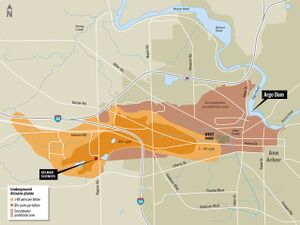Gelman dioxane plume (nonfiction): Difference between revisions
(Created page with "The '''Gelman dioxane plume''' (or '''Gelman plume''') is a groundwater plume of 1,4-Dioxane spreading through the Ann Arbor, Michigan (nonficti...") |
No edit summary |
||
| Line 1: | Line 1: | ||
The '''Gelman dioxane plume''' (or '''Gelman plume''') is a groundwater plume of [[1,4-Dioxane (nonfiction)|1,4-Dioxane]] spreading through the [[Ann Arbor, Michigan (nonfiction)|Ann Arbor, Michigan]] area, moving east through the city's west side toward West Park and branches of the Allen Creek drain system that discharge to the Huron River. | [[File:Gelman dioxane plume map.jpg|thumb|A map of the Gelman dioxane plume spreading through the Ann Arbor area, moving east through the city's west side toward West Park and branches of the Allen Creek drain system that discharge to the Huron River. Gelman Sciences is removing water from the ground using extraction wells and then treating it to remove dioxane. Treated water with lower levels of dioxane is then discharged to Honey Creek, which flows to the Huron River upstream of Barton Pond, Ann Arbor's main municipal water supply.]]The '''Gelman dioxane plume''' (or '''Gelman plume''') is a groundwater plume of [[1,4-Dioxane (nonfiction)|1,4-Dioxane]] spreading through the [[Ann Arbor, Michigan (nonfiction)|Ann Arbor, Michigan]] area, moving east through the city's west side toward West Park and branches of the Allen Creek drain system that discharge to the Huron River. | ||
== Mitigation == | == Mitigation == | ||
Revision as of 06:39, 2 May 2020

The Gelman dioxane plume (or Gelman plume) is a groundwater plume of 1,4-Dioxane spreading through the Ann Arbor, Michigan area, moving east through the city's west side toward West Park and branches of the Allen Creek drain system that discharge to the Huron River.
Mitigation
Gelman Sciences is removing water from the ground using extraction wells and then treating it to remove dioxane. Treated water with lower levels of dioxane is then discharged to Honey Creek, which flows to the Huron River upstream of Barton Pond, Ann Arbor's main municipal water supply.
Dioxane
1,4-Dioxane (or simply dioxane) is a heterocyclic organic compound, classified as an ether. It is a colorless liquid with a faint sweet odor similar to that of diethyl ether. The compound is often called simply dioxane because the other dioxane isomers (1,2- and 1,3-) are rarely encountered.
Dioxane is used as a solvent for a variety of practical applications as well as in the laboratory, and also as a stabilizer for the transport of chlorinated hydrocarbons in aluminum containers.
Dioxane has affected groundwater supplies in several areas. Dioxane at the level of 1 μg/L (~1 ppb) has been detected in many locations in the US. In the State of New Hampshire alone in 2010 it had been found at 67 sites, ranging in concentration from 2 ppb to over 11,000 ppb. Thirty of these sites are solid waste landfills, most of which have been closed for years. It also has low toxicity to aquatic life and can be biodegraded via a number of pathways. The problems are exacerbated since dioxane is highly soluble in water, does not readily bind to soils, and readily leaches to groundwater. It is also resistant to naturally occurring biodegradation processes. Due to these properties, a dioxane plume can be larger (and further downgradient) than the associated solvent plume.
- 1,4 Dioxane @ Wikipedia
Links
- Superfund option for Gelman plume back on Ann Arbor council’s agenda - January 3, 2020
- Ann Arbor considering worst-case scenario for Gelman dioxane plume - Updated May 31, 2019; Posted May 30, 2019